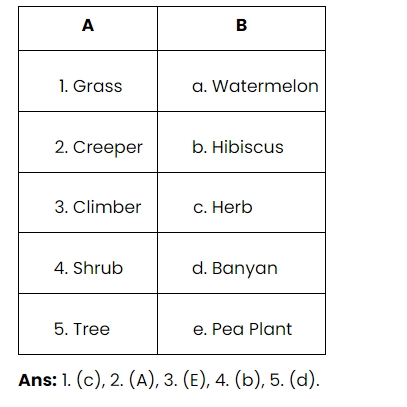
Important Questions for Class 7 Science Chapter 12: Chapter 12 of Class 7 Science, "Forests: Our Lifeline," explores the importance of forests in maintaining ecological balance. It highlights the interdependence between plants, animals, and humans, emphasizing the food chain concept. Topics include forest structure, decomposers' role, and biodiversity's significance.
Students learn how forests act as carbon sinks, provide oxygen, and prevent soil erosion. Key questions often revolve around the functions of forests, the role of decomposers, food chain examples, and the importance of conservation. Understanding human impact on forests and the need for sustainable practices is also crucial for exams.Important Questions for Class 7 Science Chapter 12 PDF
Very Short Answer Questions: 1 Mark
1. ______________ act as green lungs
a) Forests b) Industries c) Air d) Rivers
Ans: a) Forest
2. Give an example of how animals alert each other to the presence of danger.
Ans: Animals communicate with one another by producing sounds, moving to higher and safer terrain, and so on.
3. Name some animals that live deep within the forest.
Ans: Boar, bison, jackal, porcupine, elephant, tiger, lion, etc.
4. Name some forest trees.
Ans: Sal, Sheesham, Fig, Teak, Bamboo, Neem, Amla, etc.
5. Match the following.

6. Define the crown of a tree.
Ans: The crown is the branch-like region of the tree above the stem.
7. Define canopy.
Ans: The canopy is the roof-like structure formed by the branches of big trees over the other plants in the forest.
8. What are decomposers?
Ans: Decomposers are microbes that turn dead plants and animals into humus.
9. Forests are a static living community. State whether true or false.
Ans: False. Forests are a dynamic living entity undergoing lots of changes and activities.
10. ____________ traps the rain water in the forests and allows it to seep downward.
Ans: Canopy
Short Answer Questions: 3 Marks
11. Why is the canopy not uniformly green?
Ans: The leaves of all the tree branches that make up the crown and canopy will be different colours. The leaves may also be in various states of ageing and yellowing, resulting in a forest canopy that is not evenly green.
12. Why should we not go deep inside the forest?
Ans: Animals in the wild usually hide farther into the forest, away from populated areas. In contrast, human activity causes less harm to deep woodlands. Therefore, in order to protect the forest and ourselves, we shouldn't venture too far into it.
13. What are understories? How are they formed?
Ans: The understorey is the layer of plants and trees that grows beneath the forest's main canopy. The differences in height, size, and shape of the crowns of different plants create different understories.
14. What is the forest floor? State its importance.
Ans: It is the layer immediately above the soil surface in a forest. It is composed of dead and shed leaves, branches, twigs, bark, and stems in different stages of decay. Humus, which is created as the forest floor breaks down, increases the fertility of the soil.
15. Define humus. How is it formed?
Ans: Humus is a dark-colored fluid found in the topsoil that is generated by microbes decomposing organic debris such as dead plant and animal remains.
Long Answer Questions: 5 Marks
16. Explain the role of forests.
Ans: The green lungs of nature are forests. They give the surroundings oxygen and purify the air. Because the roots of the trees stop soil erosion, floods are avoided. Additionally, they preserve and enhance the fertility of the soil. The forest is home to many organisms. In terms of the environment, they are indispensable. Additionally, forests give us a range of beneficial products like timber, honey, medicinal plants, and more. Rainfall is also aided by forests.
17. Explain the importance of a food chain with examples.
Ans: A food chain is a series of organisms that consume and are eaten. An organism consumes the previous member of the food chain before being consumed by the subsequent member.
For Example: Grass 🡪 Deer 🡪 Lion.
Because it gives the organisms food, the food chain is essential. Woods are home to a variety of interrelated food networks. The balance of the forest is maintained in part by these food networks. As a result, the rest of the food chain suffers if one of the elements is damaged.
18. Explain how forests influence the water cycle.
Ans: Trees and plants can extract water from the earth and release it into the atmosphere through evaporation. Rain eventually falls from the clouds formed by the condensation of this evaporating water. In forests, a lot of trees are concentrated in a limited area.
Consequently, the soil absorbs more water and releases it into the atmosphere. Rainfall rises as a result. Groundwater levels rise as a result of increased water seeping into the soil and forest floor.
19. How do forests balance the amount of oxygen and carbon dioxide in the atmosphere?
Ans: The green leaves of trees absorb carbon dioxide from the atmosphere and release oxygen during photosynthesis. The respiration of animals depends on this oxygen. Trees and plants absorb the carbon dioxide that the animals release. Consequently, the woods' lush vegetation preserves the balance between carbon dioxide and oxygen.
20. What is the effect of rapid urbanisation on forests?
Ans: Widespread deforestation occurs as a result of rapid urbanisation in order to supply land and resources for homes and industry. The balance between carbon dioxide and oxygen is upset by deforestation. Global warming is the effect. Forests are further deteriorated by increased air, water, and soil pollution brought on by more crowded cities. Soil erosion and flooding are increasing in frequency.
Numerous plants and animals are in risk of becoming endangered or going extinct due to the devastation of their habitats caused by forests. The health of forests and its components would suffer as a result of increased forest exploitation for forest products brought on by rapid urbanisation.
Focused Preparation : Helps students concentrate on key topics like food chains, biodiversity, and forest conservation.
Concept Clarity : Reinforces understanding of complex topics like decomposers and ecological balance.
Time Management : Enables efficient revision by targeting exam-relevant questions.
Exam Confidence : Familiarity with important questions boosts confidence in tackling similar questions.
Application-Based Learning : Encourages thinking about real-world issues like deforestation and sustainable practices.
These questions ensure thorough preparation for both school exams and environmental awareness.